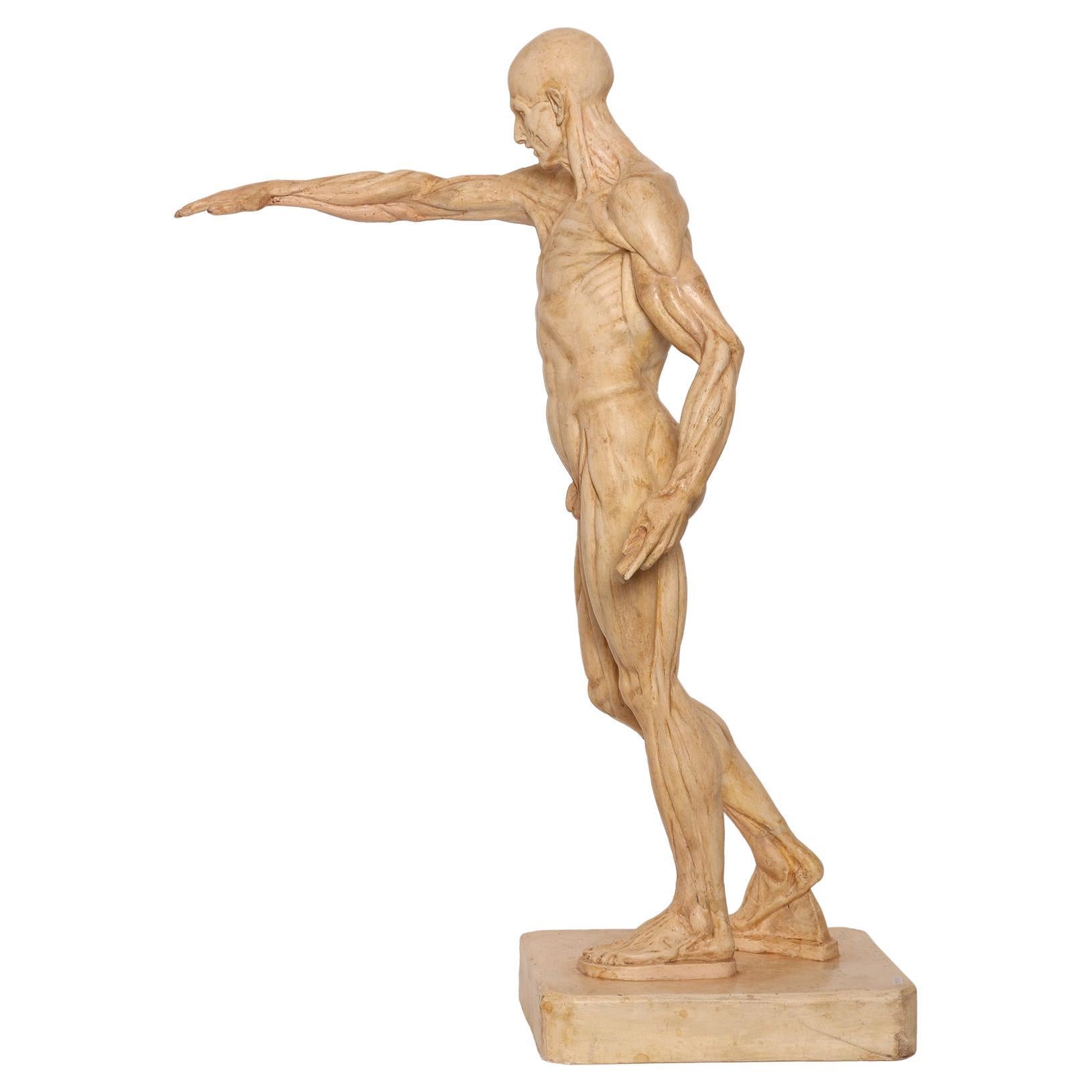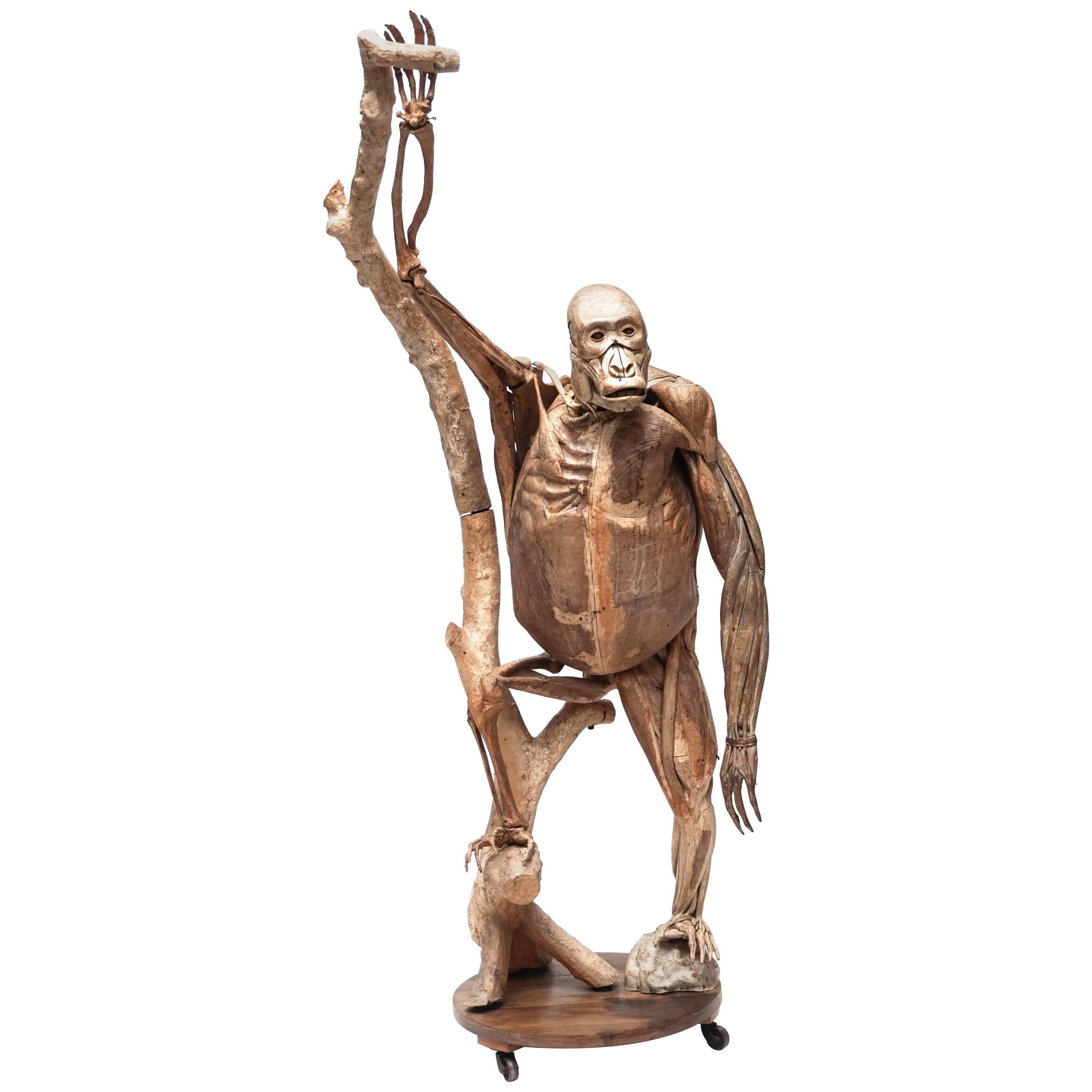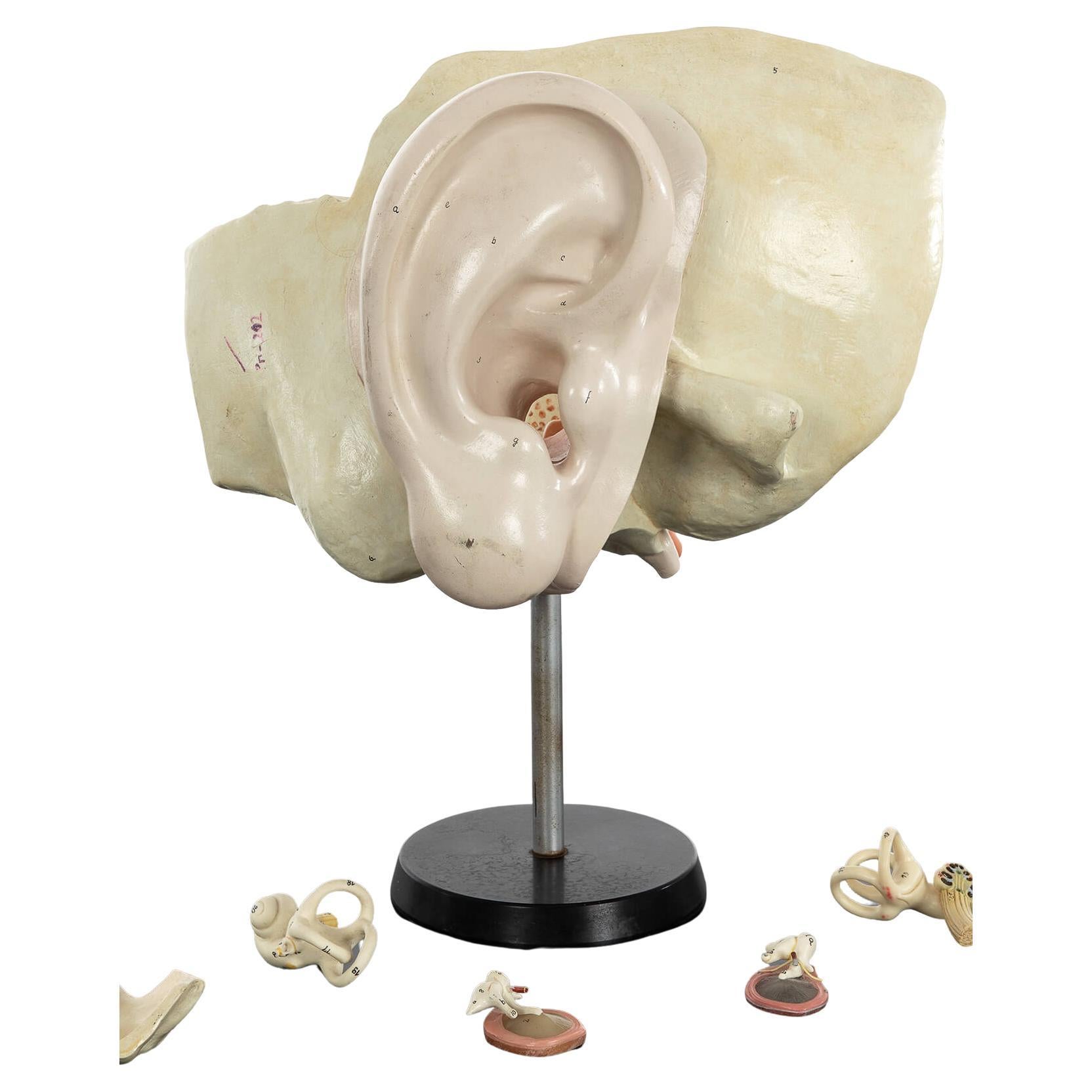Items Similar to Louis Thomas Jérôme Auzoux (1797-1880) - Skinned, Human anatomical Model
Want more images or videos?
Request additional images or videos from the seller
1 of 10
Louis Thomas Jérôme Auzoux (1797-1880) - Skinned, Human anatomical Model
About the Item
Louis Thomas Jérôme Auzoux (1797-1880)
Skinned
Human anatomical Model
Paris, around 1850
135 cm
In the 1820s Louis Auzoux, a French medical graduate made papier mâché dissectable anatomical models for teaching medicine and anatomy.
Auzoux improved upon the early papier-mâche techniques; he developed a secret mixture, wich allowed papier-mâché models to harden as a solid, supple, light and durable objets.
Auzoux model were designed to be taken to pieces and reassembled, which each part labelled, showing internal anatomy.
His models became famous at industrials shows during the second half of XIX century, such as the Great Exhibition of 1851 in London, where they received praise.
Other anatomical models by Auzoux are exposed in different museum such as British Dental Association in London, Le Musée National d’histoire naturelle de Paris and Le Musée de l’écorché d’anatomie de Neubourg.
Bibliography:
- Grob, B.W.J., ‘The anatomical models of Louis Auzoux’, in ‘ A descriptive catalogue’, Colophon, Museum Boerhaave Communication 305, Leiden, Germany, 2004
- Christophe Degueurce, ‘Corps de papier :l’anatomie en papier mâché du docteur Auzoux’, Paris, edition de La Martinière, 2012
- Marion Gouriveau, « La fabrication des modèles anatomiques en papier-mâché du docteur Auzoux », dans Claude Laroque & Valérie Lee (dir.), papiers en volumes, traditions asiatiques et occidentales : Actes de la journée d'études du 4 novembre 2016, Université de Paris-Sorbonne, HiCSA, 2018
- Collectif, Prodiges de la nature : les créations du docteur Auzoux (1797-1880), Collections de l’Université de Montpellier, Montpellier, Ministère de la Culture et de la Communication, Direction régionale des Affaires culturelles, Monuments historiques et objets d’art d’Occitanie, 2017
- Creator:Dr. Louis Auzoux (Artist)
- Dimensions:Height: 20.93 in (53.14 cm)Width: 7.29 in (18.5 cm)Depth: 6.37 in (16.17 cm)
- Style:Other (In the Style Of)
- Materials and Techniques:
- Place of Origin:
- Period:
- Date of Manufacture:around 1850
- Condition:Wear consistent with age and use. one arm is missing.
- Seller Location:Bruxelles, BE
- Reference Number:1stDibs: LU6666229612542
About the Seller
5.0
Vetted Seller
These experienced sellers undergo a comprehensive evaluation by our team of in-house experts.
1stDibs seller since 2022
6 sales on 1stDibs
Typical response time: 4 hours
- ShippingRetrieving quote...Ships From: Bruxelles, Belgium
- Return PolicyA return for this item may be initiated within 3 days of delivery.
More From This SellerView All
- Carlo Marcellini 'Florence 1644 – 1713', Florentine Baroque PuttoLocated in Bruxelles, BECarlo Marcellini (Florence 1644 – 1713) Putto White and green marble 41.5 x 73.5 cm This marble putto carved in high relief, almost a tutto tondo, and set on an elegant green marble background, appears almost naked, sitting on a cloud. His peculiar pose, in adoration, suggests that the work was a part of a larger composition including other figures in devotion. Published in 2007 by Sandro Bellesi in the monograph dedicated to Gioacchino Fortini (pg.155), this beautiful marble putto was included in the catalog of Carlo Marcellini, a prominent figure in the baroque renewal of Florentine art. Born in Florence in 1644, Carlo Marcellini received his artistic education in the city of the lily, specializing in stone sculpture and stucco modeling under the guidance of Bartolomeo Cennini before continuing his studies in Rome in the Accademia Medicea founded by the Grand Duke Cosimo III in order to familiarize some more promising artists with the essential “ taste of Rome ”. Under the guidance of Ercole Ferrata and Ciro Ferri, Giovan Battista Foggini...Category
Antique 17th Century Italian Baroque Figurative Sculptures
MaterialsMarble
- Rare Pair of Venetian Sitting Mastiffs DogsBy Venetian SchoolLocated in Bruxelles, BERare pair of sitting Mastiffs dogs. Venice, end of 15th century - first half of the 16th century. Istrian stone. Provenance: - Important private collection of an architect and scenographer from Orvieto (Umbria) A regular exportation licence delivered by the Italian Ministry of Culture accompanies the work. The representation of the dog dates back to ancient times, when dogs were considered weapons of war and used to attack the enemy or stand guard to protect strategic locations. At the entrance to the Pompei’s villa, the presence of a "cave canem...Category
Antique 16th Century Italian Renaissance Animal Sculptures
MaterialsStone
- Cerberus, Italy, 17th CenturyLocated in Bruxelles, BECerberus Black painted stone Italy, 17th century Measures: 80 x 69 x 36cm (one head missing) Cerberus, cruel monster, fierce and strange, Through his wide threefold throat barks as a dog Over the multitude immers'd beneath. His eyes glare crimson, black his unctuous beard, His belly large, and claw'd the hands, with which He tears the spirits, flays them, and their limbs Piecemeal disparts (Dante, Inferno, Canto VI). Cerberus figure seated, in his role of ferocious guardian of the underworld; he shows a nervous musculature, an adherent skin which reveals the ribs, long and robust limbs; his heads are broad and the eyes set well apart. Painted in black to amplify his menacing look, the infernal guardian is depicted with his famous attributes, writhing his heads, growling and barking furiously. Cerberus, in Greek mythology, was the monstrous watchdog of the underworld – also known as the “hound of Hades” – preventing the dead from leaving, and making sure that those who entered never left. A child of Typhon and Echidna, he was part of a monstrous family, which included Orthus, the Lernaean Hydra, and the Chimaera as well. Only on three occasions Cerberus was tricked by visitors of Hades: Heracles did it with his strength, Orpheus with his music. In "The Inferno", Dante places Cerberus as the guardian of the third circle of Hell. With his three mouths, Dante saw Cerberus as a beast that was synonymous with the sin of Gluttony. Virgil gets past the monster by throwing mud in his three mouths, temporarily choking him. Very rare are the representations of Cerberus in ancient statuary...Category
Antique 17th Century Italian Renaissance Figurative Sculptures
MaterialsStone
- Large Hexagonale Base of Pilaster in Burgundy Stone, Burgundy, 15th CenturyLocated in Bruxelles, BELarge base of molded hexagonal pilaster in burgundy stone carved with vines, grapes and rosettes in high relief. Burgundy, 15th century 28 x 63 x 30 cm Provenance : collection De...Category
Antique 15th Century and Earlier French Gothic Architectural Elements
MaterialsStone
- Gothic crowned Head - Île de France, 14th centuryLocated in Bruxelles, BEHead of a crowned Virgin Île-de-France, first half of 14th century. H26 x 14 x 14 cm Provenance : - Private Collection, Paris France (1960) - Private Collection Tuscany, Italy (19...Category
Antique 15th Century and Earlier French Gothic Figurative Sculptures
MaterialsStone
- Venus Pudica (Medici-type) - 18th century, ItalyLocated in Bruxelles, BEMonumental sculpture representing the Venus Pudica (Medici-type) 18th Century Italian (Rome) White marble Based on a model from Antiquity, the Medici Venus, currently in the Uffizi ...Category
Antique Early 18th Century Italian Grand Tour Figurative Sculptures
MaterialsMarble
You May Also Like
- Anatomical Skin Model, Italy, 1880Located in Milan, ITThe anatomical sculpture, cast out of plaster, depicts a flayed man standing over a rectangular base in a classical pose with lifted arm. Anatomical study p...Category
Antique Late 19th Century Italian Figurative Sculptures
MaterialsPlaster
- Anatomical Model of Gorilla by Dr. Louis Auzoux Plus Unique Handwritten BookletBy Dr. Louis AuzouxLocated in Haarlem, NLSinke & van Tongeren exhibited this extremely rare Auzoux Gorilla by carefully taking apart the model and creating an exploded view of this historically important piece. When viewed from a particular angle all pieces come together to form the original shape. It was part of the exhibition called ‘TIER’ at MOA in The Netherlands The story of a remarkable 19th century anatomical model created just four years after Darwin unleashed a political storm with his theories on human evolution. The publication of Charles Darwin’s controversial On the Origin of Species in 1859 caused debates to rage about human evolution, debates which witnessed the politicisation of a creature whose existence had only recently been confirmed by modern science. On one side of the argument was the Darwinian camp; on the other were those opposed to Darwin’s theory, such as Richard Owen, the famed Director of the Natural History Museum and a man who, interestingly, coined the word ‘dinosaur’. Tales of the creature in question had endured for centuries, but up until 1847 it remained a myth, an unknown. This all changed thanks to the missionary Thomas Savage and the anatomist Jeffries Wyman who wrote a paper for the journal of the Boston Society of Natural History in which they described a new species: Troglodytes gorilla. (Later, in 1929, Harvard zoologist Harold Coolidge would apply the synonym Gorilla gorilla...Category
Antique 1860s French Models and Miniatures
MaterialsPaper
- Anatomical Plaster Model of a Human EarBy SomsoLocated in Faversham, GBA rare plaster model of the human ear poised on a wooden stand. The model is made by renowned German manufacturer, SOMSO. This particular model is rare as it shows in incredible de...Category
Vintage 1960s German Mid-Century Modern Figurative Sculptures
MaterialsPlaster, Wood
- Anatomical Model of the Human EarBy SomsoLocated in Faversham, GBThe DS5 Somso model of the human ear with hand-painted detailing to both the inner and outer ear. These models are the most detailed and accurate of any anatomical models available,...Category
20th Century German Mid-Century Modern Figurative Sculptures
MaterialsResin, Plastic, Plaster
- Vintage Human Body Educational Model / Anatomical Model, circa 1940sLocated in Lucenec, SKFantastic looking vintage anatomical model of a full human body on a black granite base. The height of the model with base (4 cm) is 82 cm. Unfortunately, removable parts are missing.Category
Mid-20th Century European Mid-Century Modern Scientific Instruments
MaterialsGranite
- Anatomical Model: a Jaw with Teeth, Italy, 1880Located in Milan, ITAnatomic model for class depicting a jaw with a teeth, made out of painted papier machè mounted on round black wooden base. Italy 1880 ca.Category
Antique Late 19th Century Italian Scientific Instruments
MaterialsPlaster, Fruitwood, Paper





